Quick Facts

Biography
Walter Seymour Allward (18 November 1876 – 24 April 1955) was a Canadian monumental sculptor widely praised for his "original sense of spatial composition, his mastery of the classical form and his brilliant craftsmanship"
Allward's 1917 heroic monument, the Bell Telephone Memorial, has been seen as the finest example of his early works. It brought the sculptor to fame and led to Allward later creating the Canadian National Vimy Memorial in France, his most renowned work. Some of the sculptor's works have also been acquired by the National Gallery in Ottawa, Canada's preeminent art gallery.
Allward has been described as "...probably Canada's most important monumental sculptor in the first third of [the 20th] century".
Biography
Early life
Allward was born in Toronto, the son of John A. Allward of Newfoundland. Educated in Toronto public schools, his first job was at the age of 14 as an assistant to his carpenter father. Allward first served an apprenticeship with the architectural form Gibson and Simpson before working at the Don Valley Brick Works, where he modelled architectural ornaments. There he showed skill in clay mold making. This early training, supplemented by modelling classes at the New Technical School, prepared Allward for his lifelong career as a monumental sculptor.
Body of works
Early work
Allward's first commission was for the figure of Peace on the Memorial of the Battles in the North-West (1895) in Queen's Park, Toronto. Other early works included a life-sized figure of Dr Oronhyatekha commissioned by the Independent Order of Foresters for the opening of the Temple Building in Toronto (1899), and the Old Soldier, commemorating the War of 1812 in Toronto's Portland Square (now Victoria Memorial Square) (1903). Also in 1903, Alas elected an associate of the Royal Canadian Academy and in 1918 became a full academician. Now well established he received commissions to do busts of Lord Tennyson, Sir Charles Tupper, Sir Wilfrid Laurier and others. On the grounds of Queen’s Park are statues of General John Graves Simcoe and Sir Oliver Mowat, completed in 1903 and 1905 respectively.
Heroic monuments
Allward's true talent lay in his heroic monuments. These included the design work for the Boer War Memorial Fountain in Windsor, Ontario (1906), the South African War Memorial in Toronto (1910), The Baldwin-Lafontaine Monument on Parliament Hill in Ottawa (1914) and the Bell Memorial commemorating Alexander Graham Bell's invention of telephone in Brantford, Ontario (1917). Allward had also completed design work on a memorial to King Edward VII but the onset of the World War I prevented its completion. The figures of Veritas (Truth) and Iustitia (Justice) were cast in bronze for the memorial. They were found in their crates in 1969 buried under a parking lot, and in 1970 were installed outside the Supreme Court of Canada in Ottawa. Allward also designed numerous municipal cenotaphs around the country, including the Stratford Memorial (1922), the Peterborough Memorial (1929) and the Brant War Memorial (1933).
Bell Memorial
In 1906 the citizens of the Brantford and Brant County areas formed the Bell Memorial Association to commemorate the invention of the telephone by Alexander Graham Bell in July 1874 at his parent's home, Melville House, in Brantford, Ontario. Allward's design was the unanimous chose from among 10 submitted models, winning the competition. The memorial was originally to be completed by 1912 but Allward did not finish it until five years later. The Governor General of Canada, Victor Cavendish, 9th Duke of Devonshire, ceremoniously unveiled the memorial on 24 October 1917.
Allward designed the monument to symbolize the telephone's ability to overcome distances. A series of steps lead to the main section where the allegorical figures of Inspiration appears over a reclining male figure representing Man, the inventor, and also pointing to the floating figures of Knowledge, Joy, and Sorrow, positioned at the other end of the tableau. At each end of the memorial there are two female figures mounted on granite pedestals representing Humanity, one sending and the other receiving a message.
The Bell Telephone Memorial's grandeur has been described as the finest example of Allward's early work, propelling the sculptor to fame. The memorial itself has been used as a central fixture for many civic events and remains an important part of Brantford's history, helping the city style itself as 'The Telephone City'.
Vimy Memorial
The most important and famous commission Allward received was for the monument to commemorate Canadians killed in the First World War, a project which would occupy him from 1921 till the memorial's unveiling in 1936. Allward made 150 design sketches before submitting the design which won the commission from the Canadian federal government. The Canadian Battlefields Memorials Commission eventually selected Vimy Ridge as the location for the memorial, due largely to its elevation above the plain below, as the preferred site of Allward's design. In June 1922, Allward set up a studio in London, England and toured for more almost two years to find a stone of the right colour, texture, and luminosity for the memorial. He eventually found it in the ruins of Diocletian's Palace. Known as Seget limestone, it was a stone that came from an ancient Roman quarry located in Croatia. As a consequence, the stone had to be first quarried then shipped by boat to France and then transported to Vimy Ridge by truck and by rail.
Allward chose a relatively new construction method, a cast concrete frame to which the limestone was bonded. The memorial base and twin pylons contain almost 6,000 tonnes of Seget limestone. The 20 sculptured figures which grace the memorial were actually carved where they now stand, from the huge blocks of stone. The carvers used half-size plaster models produced by Allward in his studio and an instrument called a pantograph to reproduce the huge figures to the proper scale. All this work was carried out inside temporary studios built around each figure, including those at the top of the pylons.
Works
| Work | Date | Location | Notes | Image |
|---|---|---|---|---|
| Peace (North-West Rebellion Memorial) | 1895 | Queen's Park, Toronto | 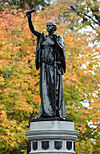 | |
| Sculpture of Oronhyatekha | 1899 | Temple Building, Toronto | Commissioned by Oronhyatekha and the Independent Order of Foresters to mark the opening of the Temple Building | |
| Old Soldier | 1903 | Victoria Memorial Square, Toronto | Commemorates the War of 1812 | 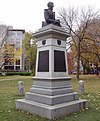 |
| Sculpture of John Graves Simcoe | 1903 | Queen's Park, Toronto | First Lieutenant-Governor of Upper Canada | 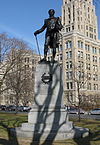 |
| Sculpture of Sir Oliver Mowat | 1905 | Queen's Park, Toronto | Third Premier of Ontario | 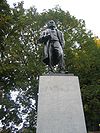 |
| Boer War Memorial Fountain | 1906 | Windsor, Ontario | ||
| Sculpture of John Sandfield Macdonald | 1909 | Queen's Park, Toronto | First Premier of Ontario | |
| South African War Memorial | 1910 | University Avenue, Toronto |  | |
| Sculpture of Robert Baldwin and Louis-Hippolyte Lafontaine | 1914 | Parliament Hill, Ottawa |  | |
| Bell Telephone Memorial | 1917 | Bell Memorial Gardens, Brantford, Ontario | Commemorates the invention of the telephone by Alexander Graham Bell in 1874 at his parent's home in Brantford, Ontario |  |
| Veritas (Truth) | 1920 | Supreme Court of Canada, Ottawa | Cast for the never finished memorial to King Edward VII, and found buried in 1969. Installed in front of the Supreme Court of Canada in 1970. | 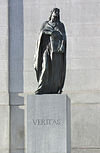 |
| Justitia (Justice) | 1920 | Supreme Court of Canada, Ottawa | See Veritas, above | 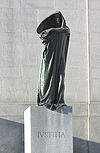 |
| Stratford Cenotaph | 1922 | Stratford, Ontario | ||
| Citizens' War Memorial | 1929 | Peterborough, Ontario | ||
| Brant County War Memorial | 1933 | Brantford, Ontario | ||
| Canadian National Vimy Memorial | 1936 | Vimy Ridge (near Vimy, Pas-de-Calais), France |  | |
| Bust of William Lyon Mackenzie | 1940 | Queen's Park, Toronto | 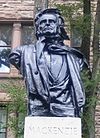 |
Legacy
The art of Walter Allward lives on in numerous substantial monument and designs in Canada and abroad. Many of his personal tools were bequeathed to his protégé Emanuel Hahn, who in turn gifted some to his protégé Elizabeth Bradford Holbrook. Today some of those tools are being used by Canadian sculptor Christian Cardell Corbet as gifted to him by his mentor Bradford Holbrook. He was first elected a member of the Royal Canadian Academy of Arts in 1903, and his bronze diploma work of 1920, The Storm, was acquired for the National Gallery of Canada. He is a character in Jane Urquhart's book The Stone Carvers. In November 2011 the Chief Justice of Canada, Beverley McLachlin unveiled a portrait bust by Christian Cardell Corbet of Walter Allward titled "Walter of Vimy" at the Supreme Court of Canada, now a part of the Courts permanent collection.
